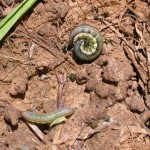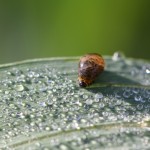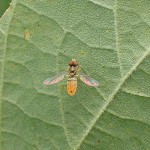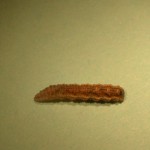True Armyworms: I’ve had no reports of any significant true armyworm infestations. UT recommends treatment when 6-8 larvae are present per square foot. You must look on the ground to get an accurate count. Once past the milk stage, wheat can tolerate much higher infestations. Recent data from Arkansas indicated little or no yield loss even with almost complete defoliation if it occurred after the milk stage. Occasionally, larvae will clip heads, so treatment after milking is usually based on whether head clipping is occurring rather than defoliation levels or larval counts. See photo below.
Cereal Leaf Beetles: Expect to start seeing more cereal leaf beetle larvae in the field. They are defoliators but only rarely cause enough injury for serious concern. The larvae are pretty easy to recognize as they cover themselves with goo and will turn you pants nasty as you walk through the field. UT recommends treating for cereal leaf beetles when one larvae or adult is present per stem, but you may need to be a little more aggressive if defoliation levels start exceeding 25-30%. Larvae feed by scouring the surface of the leaf, sometimes giving the field a whitish cast. As with armyworms, be more concerned about early infestations. Several pyrethroid insecticides (Baythroid XL, Declare, Karate/Warrior, and Mustang Max) are labeled as are Sevin XLR, Lannate and Tracer. See photo below.
Mystery Larvae: I’ve had a couple of calls about mysterious larvae being found in wheat. The descriptions varied quite a bit, but once someone sent a picture it was obvious we were talking about syrphid or flower fly larvae. The adults of these insects resemble small, delicate hovering bees. The larvae are predators, feeding almost exclusively on aphids. Their color can vary from light brown to greenish (probably different species). I’ve included some pictures below. The presence of flower fly larvae indicates that aphids are also present, but our current aphid infestations are fairly light. See photos below.
Please see http://www.utextension.utk.edu/fieldCrops/cotton/cotton_insects/pubs/PB1768-Wheat.pdf for a complete list of UT’s wheat insect control recommendations.






